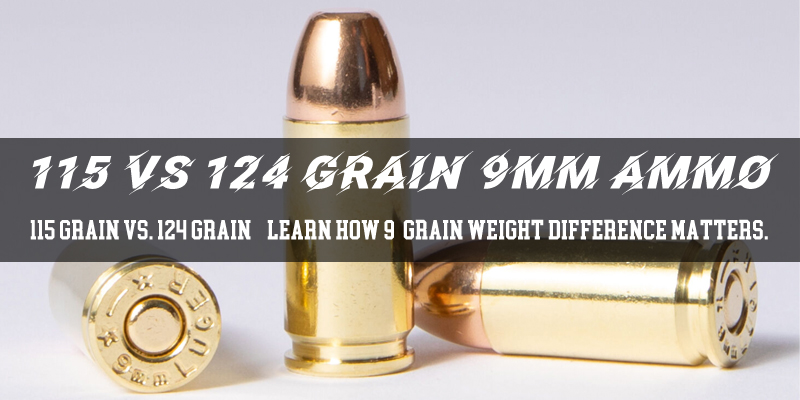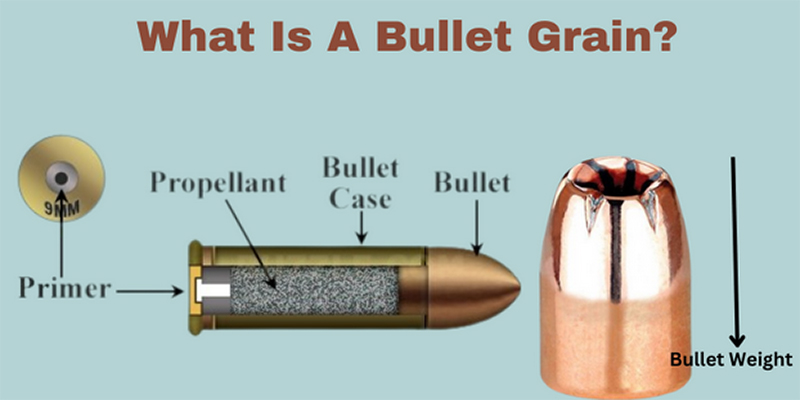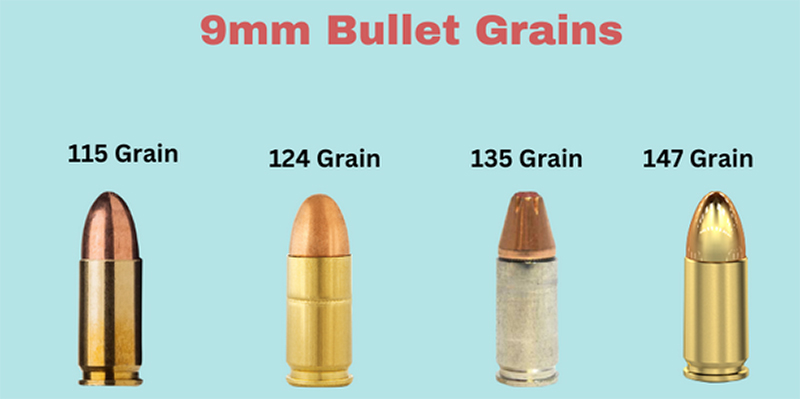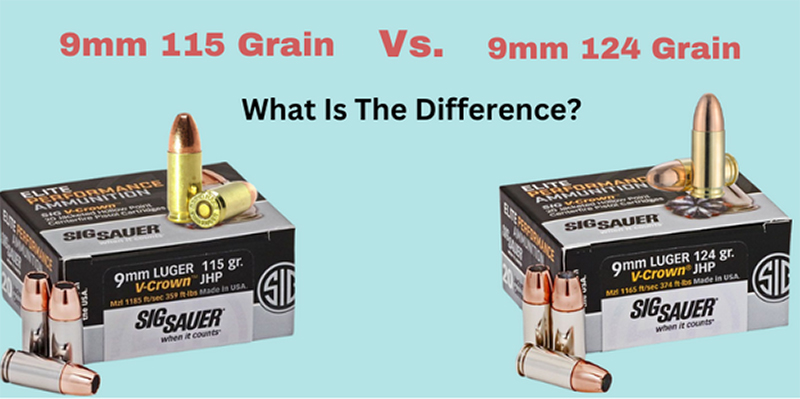115 Grain Vs 124 Grain 9mm Ammo: Know The Difference?
115 Grain Vs. 124 Grain - Learn How 9-Grain Weight Difference Matters.
When searching for 9mm ammo, different grain options are available. But the two main grain types you will find commonly are 115 grain & 124 grain.
The critical thing to know for every new shooter is, “what is the difference between 115 Grain Vs. 124 Grain 9mm ammo? And the simple answer to this question is “different bullet weight.” But that is not enough for new shooters.

This post will share detailed information about the difference between 115-grain Vs. 124 Grain 9mm ammo. This will help you choose the suitable 9mm grain to buy.
Please check our previous posts, if you want to know about 9mm ballistics & difference between 9mm Jacketed Hollow Point Vs Full Metal Jacket.
Let's get back to the topic…
What Is A Bullet Grain?

In general, grain is a unit of measurement of mass. Grains are commonly used to measure the mass of bullets and propellants. For ammo, grain means the weight of the bullet of a cartridge.
The grain of a bullet refers to the weight of the projectile portion of the ammunition. It is a unit of measurement commonly used in the firearms industry, especially for small arms ammunition such as handguns and rifles.
One grain equals 1/7,000 of a pound or 1/437.5 of an ounce. Grain is not the weight of the entire round of ammunition, but just the projectile that leaves the barrel.
Different Types of 9mm Bullet Grains

There are several types of 9mm bullet grains (the weight of the bullet) available on the market, including:
- 115 grain: This is a common weight for 9mm bullets and is often used for target shooting and self-defense. It has a muzzle velocity of around 1,200* feet per second.
- 124 grain: This weight is also common and is often used by law enforcement agencies. It has a slightly lower muzzle velocity than the 115-grain bullet, at around 1,150 feet per second**.
- 135 grain: This is a relatively new weight for 9mm bullets explicitly designed for self-defense. It has a muzzle velocity of around 1,100* feet per second.
- 147 grain: This weight is heavier than the other two and is often used for suppressed firearms or shooting at longer distances. It has a muzzle velocity of around 1,000* feet per second.
The choice of bullet grain weight depends on the firearm's intended to be used and the purpose with the shooter's preferences. Heavier bullets generally have more recoil and lower muzzle velocity, while lighter bullets have less and higher muzzle velocity.
Difference Between 9mm 115 Grain Vs 124 Grain?

The main difference between 115-grain Vs. 124-grain 9mm ammo is the weight of the bullet. In general, a 124-grain bullet is heavier than a 115-grain bullet, which means it has more mass and generally travels at a slightly slower velocity than the 115-grain bullet.
This can affect the performance of the ammunition in a few ways.
There is only a 9-grain weight difference between a 115-grain and 124-grain bullet.
Because of the different bullet weights from the same manufacturers, you can see the differences in muzzle velocity. We are sharing the table below with the comparison of 2 different bullet weights from the same manufacturer.
| Product | Bullet Weight | Muzzle Velocity |
| Federal American Eagle 9mm FMJ | 115 Grain | 1180 fps |
| Federal American Eagle 9mm FMJ | 124 Grain | 1150 fps |
| Hornady American Gunner 9mm JHP | 115 Grain | 1155 fps |
| Hornady American Gunner XTP JHP | 124 Grain | 1175 fps |
| Blazer Brass FMJ 9mm 50 Rounds | 115 Grain | 1145 fps |
| Blazer Brass FMJ 9mm 50 Rounds | 124 Grain | 1090 fps |
| PMC 9mm FMJ | 115 Grain | 1150 fps |
| PMC Bronze 9mm FMJ | 124 Grain | 1110 fps |
| Fiocchi 9mm FMJ | 115 Grain | 1200 fps |
| Fiocchi 9mm FMJ | 124 Grain | 1150 fps |
| Federal American Eagle 9mm FMJ | 115 Grain | 1180 fps |
| Federal American Eagle 9mm FMJ | 124 Grain | 1150 fps |
The above table shows that the 115-grain 9mm rounds are light and fast, and the 124-grain 9mm ammo is heavy and slow.
115 Grain Vs. 124 Grain 9mm Ammo - Recoil Differences
The most important difference between 115 gr and 124 gr is the recoil & recoil difference depending on the gun design or weight.
Because of high weight & slow movement, the 124 grain ammunition generates slightly more recoil than the 115 grain.
A simple method calculates the recoil difference between the two bullet weights. To calculate the power, you need to multiply the bullet weight (in grains) by muzzle speed (fps) & then divide the results by 1,000. By this you will find that the bullet or ammo with a higher power factor will have more power or recoil.
Lets share an example of this by using the same table. See how the power factors differ between 115-grain Vs. 124 grain 9mm ammo:
| Product | Bullet Weight | Muzzle Velocity | Power Factor** |
| Federal American Eagle 9mm FMJ | 115 Grain | 1180 fps | 135 |
| Federal American Eagle 9mm FMJ | 124 Grain | 1150 fps | 142 |
| Hornady American Gunner 9mm JHP | 115 Grain | 1155 fps | 132 |
| Hornady American Gunner XTP JHP | 124 Grain | 1175 fps | 145 |
| Blazer Brass FMJ 9mm 50 Rounds | 115 Grain | 1145 fps | 131 |
| Blazer Brass FMJ 9mm 50 Rounds | 124 Grain | 1090 fps | 135 |
| PMC 9mm FMJ | 115 Grain | 1150 fps | 132 |
| PMC Bronze 9mm FMJ | 124 Grain | 1110 fps | 137 |
| Fiocchi 9mm FMJ | 115 Grain | 1200 fps | 138 |
| Fiocchi 9mm FMJ | 124 Grain | 1150 fps | 142 |
| Federal American Eagle 9mm FMJ | 115 Grain | 1180 fps | 135 |
| Federal American Eagle 9mm FMJ | 124 Grain | 1150 fps | 142 |
So, we can say that every 124 grain round listed has a higher power factor than the 115 grain round.
115 Grain Vs. 124 Grain 9mm Ammo - Performance & Accuracy Differences
When comparing the accuracy of 115-grain and 124-grain bullets in firearms, it's important to note that several factors can influence accuracy, such as the specific firearm, ammunition quality, shooting technique, and environmental conditions. However, some differences between 115-grain and 124-grain bullets can affect their accuracy. Here are some potential factors to consider:
- Recoil: 115-grain bullets typically generate less recoil than 124-grain bullets, which can make them easier to shoot accurately for some people.
- Velocity: 115-grain bullets typically travel at higher velocities than 124-grain bullets, which can make them more accurate at longer ranges due to less drop.
- Bullet design: The design of the bullet can also play a role in accuracy. Some bullets may be designed with a longer, more aerodynamic shape that helps them maintain velocity and accuracy.
Ultimately, the best way to determine which bullet weight is more accurate for a particular firearm is to test both types of ammunition and compare the results. Some firearms may perform better with one weight over another, while others may not show a significant difference in accuracy between the two.
115 Grain Vs. 124 Grain 9mm Ammo Uses
115-grain and 124-grain bullets can be used for various purposes, including self-defense, target shooting, and competition shooting. Here are some specific uses for each:
Uses of 115 Grain Bullets:
- Self-defense: 115-grain bullets are a popular choice for self-defense due to their higher velocity and flatter trajectory. This can help ensure accurate shots in stressful situations.
- Target shooting: 115-grain bullets can be used for target shooting due to their lighter weight and lower recoil. They can also be cheaper than heavier bullets, making them a more economical option for some shooters.
- Competition shooting: 115-grain bullets can be used in sports shooting, especially in exercises that require fast shooting and quick transitions between targets.
Uses of 124 Grain Bullets:
- Self-defense: 124-grain bullets can also be used for self-defense and are popular among some shooters due to their slightly better penetration and ultimate ballistics. They can also be more accurate than the 115-grain bullets found in some weapons.
- Target shooting: 124-grain bullets can be used for target shooting, especially for more extended-range shooting where a heavier weight can help maintain accuracy at range.
- Competition shooting: 124-grain bullets are a popular choice, especially on shooting courses requiring more precision and accuracy.
The choice between 115 grain and 124 grain bullets will depend on personal preference and the specific needs of the shooter. Both can be effective for a variety of purposes and can be used in a wide range of firearms.
Final Words: What 9mm Grain Bullet is Best?
In conclusion, the choice between 115 grain Vs. 124 grain 9mm ammunition ultimately comes down to personal preference and the intended use of the ammunition. In general, 115 grain bullets are lighter and faster. These types of bullets are a popular choice for target shooting and self defense due to their higher velocities.
On the other hand, 124-grain bullets tend to be slightly heavier and slower, which can result in slightly better penetration and terminal ballistics. They may also be somewhat more accurate in some firearms.
It's important to choose 9mm ammunition that you're comfortable shooting and that meets your specific needs.
Try out different bullet weights and see what works best for you and your firearm. With the right ammunition, you can maximize your accuracy and performance on the range or in a self-defense situation.

